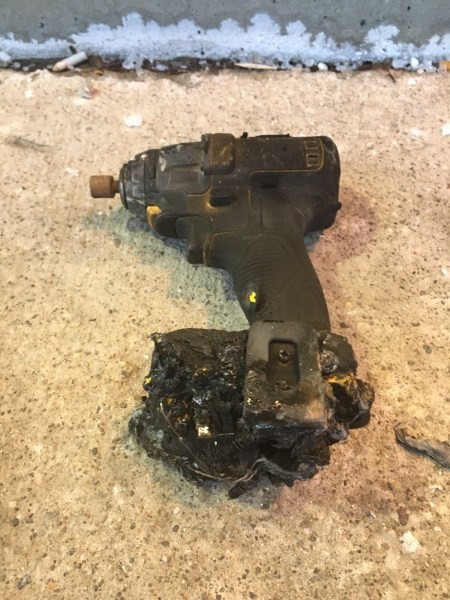
We regularly see stories about Lithium-Ion Batteries (LIBs) bursting into flames and causing a lot of damage. We mostly hear such stories in relation to cars, EVs, but I was told of in incident recently that really shocked me.
A friend has a few work boats, used to provide inshore services to ports, harbours, marinas and the like. He called me a couple of weeks ago to tell me that one of them had exploded and had suffered serious damage. The explosion was caused by, as you have guessed, a LIB.
Photos he sent showed extensive damage. The LIB had been placed outside the engine room (ER), on the other side of the ER bulkhead, or wall. The highly stiffened bulkhead, of 11-12mm thick steel, was deformed several inches inwards into the ER, and all the welding around its periphery had cracked. The extremely highly stiffened structure under the engine was badly buckled, and there were signs that the hull had been deformed. A one-inch-thick teak door on the Bridge had been blown clean off its hinges and could not be found. All the windows were gone.
People five mile away reported the explosion.
There was, strangely enough, no significant fire or heat damage, but the explosion was obviously a major one. The boat’s insurers have declared the boat, valued at almost a million pounds all in, a constructive total loss, meaning it is beyond economic repair.
No doubt most of you will be thinking, like I did, that it must have been one hell of a big battery. I assumed it was used to start the engine. But no. Not at all. It was one of these.

Yes, folk it was a small battery, for a hand-held cordless tool, like those used in countless hand drill, impact wrenches, small chain saws, garden strimmers and the like, which many people keep in their homes.
I don’t have much detail of the actual battery, but I’m told it had a rating of 0.72kWh, which may be wrong as it seems too high. However, the important thing to know about these batteries is that they can give off dangerous vapour in the range of 500 – 6,000 ltr/per kWh, and that vapour can be up to fifty percent hydrogen, with the rest made up of carbon monoxide, methane, ethane, hydrofluoric and hydrochloric acids, and hydrogen cyanide.
If the battery was 0.72 kWh, then it could have produced between 360 to 4,000 litres of vapour, around half of which could have been hydrogen.
One of the characteristics of a hydrogen vapour is that it is so easily ignited, a few millijoules of energy, such as would be generated by dropping a 5p coin from waste height. And then bang. A very big bang.
Here’s a very short video of a test on a LIB, showing the power of an explosion.
The technical term for this bloody big bang is an unconfined vapour cloud explosion, a dramatic phenomenon that generates a severe pressure wave with a high potential to damage. You don’t want to be close when one goes off.
Fortunately for my mate, the explosion occurred out of working hours. A few hours either way and it could have killed him. The explosion can generate jet flames of around 1,200°C.
Digging around a bit, LIB’s can degrade because of a manufacturing defect, overheating, incorrect charging or an internal short circuit. Certainly, if you have one that gets very hot, or starts to bulge, dump it quickly and steer clear of it. Another sign that the battery is thinking of going bang is if it discharges too quickly. Lithium-ion battery fires are difficult to put out. Bigger batteries, such as those used in electric vehicles, may reignite hours or even days after the event, even after being cooled.

Information is hard to come by, especially in regard to cordless hand tools, but current data suggests that in 2023, there were 338 LIB fires on e-bikes, and e-scooters alone, and that discarded LIB batteries are responsible for an estimated 201 fires a year.
Another source thought that the number of fires linked to lithium-ion batteries in the UK increased by 46 per cent in 2023, compared with the previous year, and that batteries powering electric vehicles such as e-bikes, e-scooters and electric cars were responsible for almost three fires a day last year. That same source said “The UK Government needs to impose more stringent safety requirements to reduce fire frequency. Increasing awareness of proper maintenance, storage and disposal of lithium-ion batteries is paramount to protecting people and property.”
I have spoken to people I know who deal with such incidents, and while nobody would speak on the record, my strong impression is that they had advised the authorities, who have done little or nothing to protect the public. One said that he thought it was because of the NetZero-driven drive to electrification and, that if a diesel- or petrol-powered hand tool was as prone to explosion, they’d be banned in a flash.
This is pure speculation of course, but doesn’t it have the ring of truth?
Explosions of LIBs on hand tools are still uncommon, but more common than we would hope, and are likely to become more so, as the switch to battery-powered equipment accelerates. All I can advise is not to keep them in the house and look out for overheating and bulging.
Good luck!
And to end, here’s a couple of short videos showing that you just might need it.